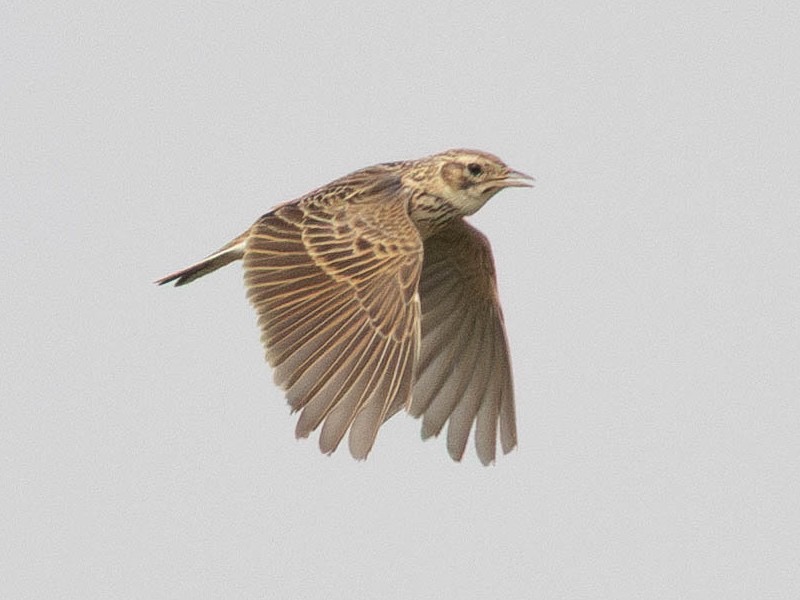Oriental Skylark Alauda gulgula 小雲雀
Category I. Rare winter visitor, much declined from last century when it was common in winter and a rare breeding species.
IDENTIFICATION
Very similar to Eurasian Skylark compared to which it is slightly smaller and has a relatively longer, thinner and more pointed bill, a shorter tail with more buffish outer tail feathers, a shorter primary projection and a smaller crest (Alström 2020).

May 2025, Ian Tam. Possibly an ex-captive individual.
The lack of a distinct white trailing edge to the inner wing is a key feature in flight.
VOCALISATIONS
The most distinctive call is a short, buzzing call that falls in pitch.
The song is similar to that of Eurasian Skylark but is more rapid, less varied and more repetitive.
DISTRIBUTION & HABITAT PREFERENCE
Oriental Skylark is found in open areas with short grass, especially airfields, landfills and reclamations, and occasionally the edges of fish ponds. Most reports are from Kowloon, Chek Lap Kok, Long Valley and the Deep Bay area.
OCCURRENCE
Oriental Skylark is much declined compared with the last century and is now recorded less than annually. Data from standardised counts during the five period 1975-1979 when the former airfield at Kai Tak was systematically surveyed (Melville 1980) are considered to provide the most accurate picture of a time when it was of regular occurrence (Figure 1). They indicate that it occurred in all months but was present in greatest numbers between November and April. Counts of 30 or more were made on 19 dates, the highest being 41 on 15 December 1975 and 52 on 20 April 1979, the latter possibly including fledged young.
The highest count in the 1990s was 20 at Tsim Bei Tsui on 20 April 1995 and at Tin Shui Wai landfill on 21 October 1997. While the highest count in the subsequent decade was 33 on 19 February 2004, all other counts were ten or fewer and it had ceased to occur annually; in the most recent decade 2011-20, there have only been seven records, all of singles.
Prior to 1958, Herklots (1953) stated that it was a ‘rare resident’ without giving further details. It presumably went largely undetected among pipits until Walker (1958) reported ‘small flocks of up to 30 birds’ feeding with pipits between 30 October and 26 February at Mai Po and the former Ping Shan marshes.
La Touche (1931-34) stated that this species was a favourite with Chinese bird-fanciers and was found in great numbers as a cage bird. It was imported into HK from China during 1965-1980 (Melville 1982) and, along with other lark species, wild-caught birds may still be seen caged in bird shops.
BEHAVIOUR, FORAGING & DIET
No observations.
BREEDING
Breeding was confirmed at two sites. A nest with three eggs was found on infilled fish ponds at Tin Shui Wai on 5 April 1993; the eggs subsequently hatched on 15th or 16th and three young were seen in the nest on 19th. In addition, an almost fully-fledged juvenile was seen at Kai Tak on 5 July 1974; food-carrying was also noted there the following year on 16 July.
Records in 2001 at Fung Lok Wai of a bird in song in February and a recently-fledged juvenile in June suggest that breeding probably took place that year, but these are the last such reports.
RANGE & SYSTEMATICS
Occurs from east and south Kazakhstan south through central Asia to the Indian subcontinent and east through the Himalayas to much of China away from the northwest and northeast, and south to Indochina and the Philippines; western and northern populations are migratory (Alström 2020). In China a summer visitor to high altitude areas of the southwest and resident south of the Yangtze (Liu and Chen 2020), though the pattern of records illustrated in Figure 1 indicates seasonal migration occurs in southeast China.
Polytypic. Of the approximately 12 subspecies, that relevant to HK is A. g. coelivox, which breeds in north Vietnam and south China. In addition, A. g. weigoldi breeds in central and east China, and could occur.
CONSERVATION STATUS
IUCN: Least Concern. Population trend unknown.
Figure 1.

Alström, P. (2020). Oriental Skylark (Alauda gulgula), version 1.0. In Birds of the World (J. del Hoyo, A. Elliott, J. Sargatal, D. A. Christie, and E. de Juana, Editors). Cornell Lab of Ornithology, Ithaca, NY, USA. https://doi.org/10.2173/bow.orisky1.01
Herklots, G. A. C. (1953). Hong Kong Birds. South China Morning Post, Hong Kong.
La Touche, J. D. D. (1931-34). Handbook of the birds of Eastern China Vol. 2. Taylor and Francis, London.
Liu, Y. and Y. H. Chen (eds) (2020). The CNG Field Guide to the Birds of China (in Chinese). Hunan Science and Technology Publication House, Changsha.
Melville, D. (1980). Birds at Kai Tak Airport, Hong Kong. Agriculture and Fisheries Department, Hong Kong.
Melville, D. S. (1982). A preliminary survey of the bird trade in Hong Kong. Hong Kong Bird Report 1980: 55-102.
Walker, F. J. (1958). Field observations on birds in the Colony of Hong Kong. Hong Kong Bird Watching Society, Hong Kong (duplicated).

